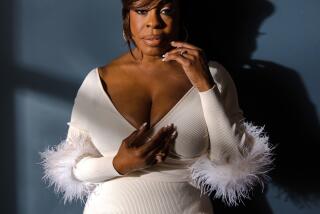Desi Arnaz, TV Lucy’s Loving Co-Star, Dies
- Share via
Desi Arnaz, a refugee Cuban conga player who loved Lucy for 10 of the most entertaining and profitable years in television history, died early Tuesday of cancer.
The bandleader-executive whose business acumen doomed live television and made him and Lucille Ball multimillionaires, was 69 and died in his home in Del Mar, a San Diego suburb. His daughter, Lucie, was at his side. His son Desi Jr. was reportedly en route.
Arnaz’s doctor, Charles Campbell, said the musician-actor died of lung cancer. “It was from smoking those Cuban cigars; that’s the truth,” Campbell said.
Reports that Arnaz was seriously ill had circulated since 1981, when he was hospitalized for what his last wife, Edith (who died in 1985), said was a flare-up of diverticulitis, an inflammation of the intestinal tract for which he had undergone four operations in 1969 and 1970.
In a statement issued from her Los Angeles office, Miss Ball said:
“Mr. Arnaz had been ill with cancer for many months, and my family and I have been praying for his release from this terrible ordeal. Desi died early this morning in his daughter’s arms. Our relationship had remained very close, very amiable, over the years, and now I’m grateful to God that Desi’s suffering is over.”
Long-Running Series
From Oct. 15, 1951, to Sept. 24, 1961, Arnaz was Ricky Ricardo on the “I Love Lucy” TV series, the forbearing spouse of a wacky wife who spent much of her time trying to convince her musician husband that she too belonged in show business.
Arnaz as Ricky led the band at the mythical Tropicana Club, often singing his signature song “Ba-ba-loo.” Offstage he spent most of his days trying to placate the Lucy he was devoted to but wanted as an uncomplicated housewife.
Arnaz’s broken English, coupled with the comedic skills of Miss Ball and complemented by their neighbors and friends, Fred and Ethel Mertz, conspired to transform that simple plot line into a show that for 190 episodes and through thousands of reruns kept 10 million American families glued to the 15 million TV sets then extant in the land.
In an interview with The Times in 1983, Arnaz attributed the show’s success to the affection he and Miss Ball had for each other.
“Everything happened to fit. The writers were great. The other couple (the Mertzes) was great . . . and the audience knew we loved each other. . . . Underneath all that crap was that Lucy and Ricky loved each other.”
From 1952 to 1958, the show never ranked lower than third among all programs on the air. And the ratings were never higher than on the night of Jan. 19, 1953, when an estimated 44 million viewers saw Lucy Ricardo give birth to Ricky Jr. on the air as Miss Ball was giving birth to her second child, Desiderio Alberto Arnaz y de Acha IV, at home.
The show had been filmed two months earlier.
The father of that infant, Desiderio Arnaz III, son of the mayor of Santiago, had come to the United States in 1933, when he was 16. He and his father were fleeing a revolution.
They landed in Miami and, from odd jobs, young Desi progressed to playing guitar and drums with a rumba band. Xavier Cugat hired him and took him to New York, but Arnaz was back in Miami before he was 20, this time leading his own band.
He popularized the conga line in this country, in which dancers snake around the floor holding onto each other and chanting “1, 2, 3, Kick.” He said he had first seen the dance at carnival time in his native land.
Met in Hollywood
He landed a role in a Broadway show, “Too Many Girls,” and met Miss Ball when he came to Hollywood to make a film of that stage production. Within six months of their meeting, they had married.
Between Arnaz’s Army service in World War II and his band tours after the war, the couple were apart during many of the early years of their marriage.
She divorced him twice, the first time in 1944 when she told Los Angeles Superior Court Judge (now a state Supreme Court justice) Stanley Mosk that Arnaz, an Army sergeant, “always ran out rather than talk (their problems) out.” They reconciled a few days later, however.
They divorced a second and final time in 1960, with her testifying that he was given to irrational rages.
“He was a great showman, a great business executive,” Miss Ball told the Ladies Home Journal in 1983. “I was very proud of him. . . . I still am. He built an empire. It was unfortunate that he also liked to let things fall apart. But there are a lot of people like that. They build and they destroy.”
The former bandleader and conga player drank and left her for long periods, she said, making her a virtual recluse in her home.
‘My Favorite Husband’
Thus in 1951, when CBS decided to move her radio series, “My Favorite Husband,” to television, Miss Ball insisted that Arnaz be a part of the show so that they could be together. The couple also insisted that the show be filmed in front of a live audience and that they be allowed to film it in California rather than in New York, where most national television was then being done.
The network was hesitant about Arnaz’s appeal, so the two went on a national personal appearance tour that proved so popular that CBS had to relent.
They borrowed $5,000 and formed Desilu Productions to produce a pilot episode of what became “I Love Lucy.” With cinematographer Karl Freund, Arnaz pioneered a three-camera filming technique that is widespread today in which three cameras simultaneously film from different angles, with a final program combined later.
The process added $5,000 to the $19,500 weekly budget of the show, and CBS and sponsor Philip Morris agreed to put up an additional $2,000 each if Arnaz would pay the remaining $1,000.
He agreed, but only if he and his wife could own the shows. A few years later he sold them to CBS for a reported $4.5 million.
Produced Other Shows
By 1957 Desilu was doing well enough to purchase RKO Studios for $6 million and produce during the seasons of 1955-57 nearly 700 half-hours of television for networks and syndication. The 19 shows they produced included “Our Miss Brooks,” “December Bride” and “The Danny Thomas Show.”
Through “Westinghouse Desilu Playhouse” productions came the prototypes of such later dramatic triumphs as “Twilight Zone” and “Mission: Impossible.” Arnaz also produced in 1959 “The Untouchables,” a violent series about special agents battling mobsters in the Prohibition era that was the genesis of a television crime wave over the next few years.
Arnaz sold his Desilu interest to Miss Ball in 1963, three years after the couple divorced. At the time the company was grossing $25 million a year. He made a producing comeback in 1967 with “The Mothers-in-Law” television series and made scattered appearances throughout the 1970s. In 1982 he made a final film appearance in Francis Ford Coppola’s “The Escape Artist.”
He also wrote an autobiography which he titled simply “A Book.” Miss Ball once suggested that his autobiography should be titled--like their first show together--”Too Many Girls.”
More to Read
The complete guide to home viewing
Get Screen Gab for everything about the TV shows and streaming movies everyone’s talking about.
You may occasionally receive promotional content from the Los Angeles Times.






